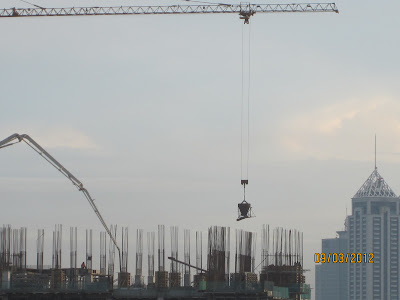I see this view from my little apartment everyday. I have been watching the work proceed, but slowly. In the 3 & 1/2 months we have been here, they have completed just 1/2 of the upper most floor of this building. It is hard to see, but there are several cranes perched atop the various buildings in the photo. They are of various sizes and colors. I could easily mistake them for the national bird.
On a small scale, you can see the hollow block (as thy call it) with rebar sticking up to keep it all together as they proceed upward. Most homes and small building will be left 'as is' with the block exposed. Only those homes and buildings that have a big budget will get stucco on the outside to give a finished look.
On a large scale, the rebar shoots skyward as the building progresses. If you look closely, you can see the concrete bucket at the end of the crane. They are pouring the outside supports of the building. These buildings are not flexible at all and would never meet code in the US. After the frame is poured out of concrete and rebar, hollow block fills in all the openings, less the window frames.
The process is very slow and labor intensive. Hundreds of workers are on this project daily. Labor is cheap in comparison to the US. A typical laborer will make about 300 to 400 Pecos A DAY (about 8 to 10 dollars). Due to the high expense, very little steel is used in construction here. It must be imported which adds to the great cost.
Even with the different dynamics of building, they have very pleasing tall buildings. Also very interesting is the location of these buildings. There are often adjacent to very poor areas.





Thanks for sharing this post! For steel supplies, visit TKL Hardware and Construction.
ReplyDeletenice article! If you're looking fordirect supplier of construction materials I recommend Topmost check their website
ReplyDelete